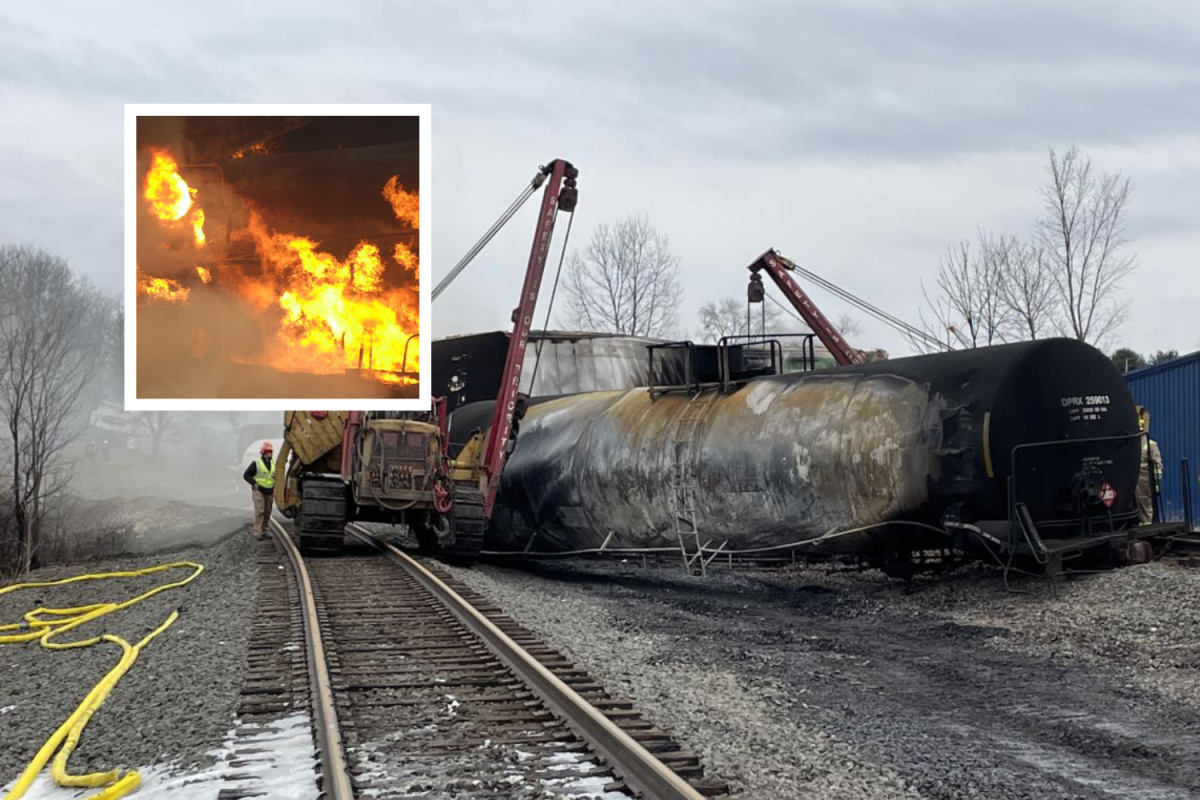Assessing The Long-Term Effects Of Toxic Chemicals From The Ohio Train Derailment

Table of Contents
Environmental Contamination and its Long-Term Impacts
The release of hazardous substances, including vinyl chloride, butyl acrylate, and other toxic chemicals, has resulted in widespread environmental contamination with potentially devastating long-term consequences.
Soil and Water Contamination
The spilled chemicals have permeated the soil and water systems, posing a significant threat to both ecological balance and human health. The persistence of these chemicals is a major concern. Vinyl chloride, for instance, is known to persist in the environment for extended periods, leaching into groundwater and potentially contaminating drinking water supplies for years to come. This long-term groundwater contamination necessitates extensive and costly remediation efforts.
- Leaching into groundwater: The porous nature of the soil allows for the easy migration of these chemicals into groundwater aquifers, impacting drinking water sources.
- Bioaccumulation in the food chain: The chemicals can accumulate in plants and animals, moving up the food chain and ultimately affecting human health through consumption.
- Soil remediation challenges: Cleaning contaminated soil is a complex and lengthy process, often requiring extensive excavation and specialized treatments.
- Long-term monitoring needs: Continuous monitoring of soil and water quality is crucial to track the spread and persistence of these contaminants and evaluate the effectiveness of remediation efforts.
Air Quality and Respiratory Health
The immediate release of airborne toxins resulted in significant respiratory problems for residents in the affected area. However, the long-term impact on air quality and respiratory health remains a major concern. The persistence of airborne pollutants, even at low levels, can lead to chronic respiratory illnesses such as asthma, bronchitis, and other respiratory diseases.
- Persistence of airborne pollutants: Some chemicals released can remain in the air for extended periods, leading to prolonged exposure.
- Impact on vulnerable populations (children, elderly): Children, the elderly, and individuals with pre-existing respiratory conditions are particularly vulnerable to the long-term effects of poor air quality.
- Long-term studies needed to assess full impact: Comprehensive, long-term studies are essential to fully understand the consequences of this exposure on respiratory health.
- Increased healthcare costs: The increased incidence of respiratory illnesses will undoubtedly lead to a substantial increase in healthcare costs for individuals and the public health system.
Impact on Wildlife and Ecosystems
The Ohio train derailment has had a devastating impact on local flora and fauna. The immediate effects included the death and injury of wildlife, but the long-term consequences for biodiversity and ecosystem health are far-reaching. Disruption of food chains and habitat loss can lead to long-term ecological imbalances, potentially causing irreversible damage to the ecosystem.
- Death and injury of wildlife: Numerous reports documented immediate casualties among local wildlife.
- Disruption of food chains: The contamination of plants and animals affects the entire food web, creating cascading effects throughout the ecosystem.
- Habitat loss and degradation: The contamination makes large areas unsuitable habitats for various species.
- Long-term monitoring of ecological recovery: Long-term monitoring is vital to assess the pace and extent of ecological recovery and inform future conservation efforts.
Public Health Concerns and Long-Term Effects on Human Health
The long-term effects of toxic chemical exposure on human health are a critical concern following the derailment.
Immediate Health Impacts and Long-Term Risks
While immediate health impacts like headaches, nausea, and eye irritation were widely reported, the potential for long-term health problems is even more troubling. Exposure to these chemicals may increase the risk of cancer, reproductive issues, and neurological disorders, though establishing direct causality will be challenging.
- Increased cancer rates: Many of the chemicals released are known carcinogens, potentially leading to a long-term increase in cancer rates in the affected population.
- Reproductive health problems: Exposure to certain chemicals can significantly impact reproductive health, potentially leading to birth defects and infertility.
- Neurological disorders: Some chemicals can cause neurological damage, resulting in long-term cognitive impairments and neurological disorders.
- Long-term health monitoring programs: Comprehensive, long-term health monitoring programs are crucial to track the occurrence of these health issues and assess their connection to the chemical exposure.
Psychological Impacts and Community Health
Beyond physical health, the derailment has inflicted significant psychological trauma on residents. The uncertainty, fear, and disruption caused by the event have led to widespread anxiety, stress, and PTSD. Community health and well-being are deeply intertwined with the psychological impacts of this disaster.
- Anxiety and stress disorders: The stress of evacuation, uncertainty about long-term health, and the environmental damage have resulted in high levels of anxiety and stress disorders.
- PTSD: The traumatic experience of the derailment and its aftermath can lead to the development of Post-Traumatic Stress Disorder (PTSD).
- Community resilience: Building community resilience and providing adequate mental health support are essential for the long-term recovery of the affected communities.
- Access to mental health resources: Ensuring access to mental health services and support for all residents, particularly those most vulnerable, is crucial.
Government Response and Long-Term Remediation Efforts
The government's response to the Ohio train derailment has been a subject of ongoing scrutiny. The adequacy of cleanup efforts and long-term remediation plans, along with the transparency and communication surrounding the disaster, are all crucial aspects needing careful examination.
- Cleanup strategies: The effectiveness of the implemented cleanup strategies and their long-term implications need ongoing evaluation.
- Environmental regulations: The derailment highlights the need for stricter environmental regulations and safety measures for the transportation of hazardous materials.
- Funding for long-term remediation: Adequate and sustained funding for long-term remediation efforts is essential for addressing the environmental contamination.
- Community involvement in decision-making: Transparency and the inclusion of affected communities in decision-making processes are crucial for building trust and ensuring effective remediation.
Conclusion
The Ohio train derailment's long-term effects of toxic chemicals present a significant challenge to environmental and public health. Assessing the long-term impact requires comprehensive monitoring of environmental contamination and ongoing health assessments of affected populations. Understanding the lasting effects of this disaster necessitates sustained funding for remediation efforts, improved safety regulations, and transparent communication with the affected communities. Monitoring the long-term consequences will be crucial for mitigating future risks. We urge readers to stay informed about the ongoing situation, support affected communities, and demand accountability to prevent future disasters through improved transportation safety and stricter regulations for hazardous materials. Let’s work together to ensure a comprehensive response to this crisis and prevent similar tragedies from happening again.

Featured Posts
-
 18 Brazilian Nationals Charged Major Gun Trafficking Bust In Massachusetts
May 24, 2025
18 Brazilian Nationals Charged Major Gun Trafficking Bust In Massachusetts
May 24, 2025 -
 Sylvester Stallone Returns In Tulsa King Season 2 Blu Ray An Exclusive Sneak Peek
May 24, 2025
Sylvester Stallone Returns In Tulsa King Season 2 Blu Ray An Exclusive Sneak Peek
May 24, 2025 -
 Jonathan Groffs Broadway Opening Lea Michele And Co Stars Show Support
May 24, 2025
Jonathan Groffs Broadway Opening Lea Michele And Co Stars Show Support
May 24, 2025 -
 Ferrari 296 Speciale Detalhes Do Motor Hibrido De 880 Cv
May 24, 2025
Ferrari 296 Speciale Detalhes Do Motor Hibrido De 880 Cv
May 24, 2025 -
 Gryozy Lyubvi Ili Ilicha Gazeta Trud Retsenziya I Obsuzhdenie
May 24, 2025
Gryozy Lyubvi Ili Ilicha Gazeta Trud Retsenziya I Obsuzhdenie
May 24, 2025
